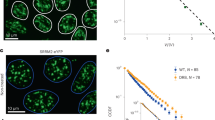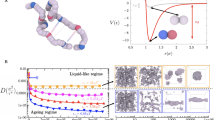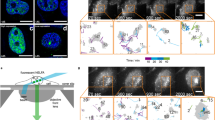Abstract
All structures within living cells must form at the right time and place. This includes condensates such as the nucleolus, Cajal bodies and stress granules, which form via liquid–liquid phase separation of biomolecules, particularly proteins enriched in intrinsically disordered regions (IDRs)1,2. In non-living systems, the initial stages of nucleated phase separation arise when thermal fluctuations overcome an energy barrier due to surface tension. This phenomenon can be modelled by classical nucleation theory (CNT), which describes how the rate of droplet nucleation depends on the degree of supersaturation, whereas the location at which droplets appear is controlled by interfacial heterogeneities3,4. However, it remains unknown whether this framework applies in living cells, owing to the multicomponent and highly complex nature of the intracellular environment, including the presence of diverse IDRs, whose specificity of biomolecular interactions is unclear5,6,7,8. Here we show that despite this complexity, nucleation in living cells occurs through a physical process similar to that in inanimate materials, but the efficacy of nucleation sites can be tuned by their biomolecular features. By quantitatively characterizing the nucleation kinetics of endogenous and biomimetic condensates in living cells, we find that key features of condensate nucleation can be quantitatively understood through a CNT-like theoretical framework. Nucleation rates can be substantially enhanced by compatible biomolecular (IDR) seeds, and the kinetics of cellular processes can impact condensate nucleation rates and specificity of location. This quantitative framework sheds light on the intracellular nucleation landscape, and paves the way for engineering synthetic condensates precisely positioned in space and time.
This is a preview of subscription content, access via your institution
Access options
Access Nature and 54 other Nature Portfolio journals
Get Nature+, our best-value online-access subscription
$29.99 / 30 days
cancel any time
Subscribe to this journal
Receive 51 print issues and online access
$199.00 per year
only $3.90 per issue
Buy this article
- Purchase on Springer Link
- Instant access to full article PDF
Prices may be subject to local taxes which are calculated during checkout



Similar content being viewed by others
Code availability
Custom code used to process and analyse the images, as detailed in the Methods, is available from the corresponding authors upon reasonable request.
References
Shin, Y. & Brangwynne, C. P. Liquid phase condensation in cell physiology and disease. Science 357, eaar4382 (2017).
Banani, S. F., Lee, H. O., Hyman, A. A. & Rosen, M. K. Biomolecular condensates: organizers of cellular biochemistry. Nat. Rev. Mol. Cell Biol. 18, 285–298 (2017).
Kashchiev, D. Nucleation (Elsevier, 2000).
Auer, S. & Frenkel, D. Prediction of absolute crystal-nucleation rate in hard-sphere colloids. Nature 409, 1020–1023 (2001).
Mitrea, D. M. et al. Nucleophosmin integrates within the nucleolus via multi-modal interactions with proteins displaying R-rich linear motifs and rRNA. eLife 5, e13571 (2016).
Sanders, D. W. et al. Competing protein-RNA interaction networks control multiphase intracellular organization. Cell 181, 306–324.e28 (2020).
Martin, E. W. et al. Valence and patterning of aromatic residues determine the phase behavior of prion-like domains. Science 367, 694–699 (2020).
Wang, J. et al. A molecular grammar governing the driving forces for phase separation of prion-like RNA binding proteins. Cell 174, 688–699.e16 (2018).
Bracha, D. et al. Mapping local and global liquid phase behavior in living cells using photo-oligomerizable seeds. Cell 175, 1467–1480 (2018).
Shin, Y. et al. Liquid nuclear condensates mechanically sense and restructure the genome. Cell 175, 1481–1491.e13 (2018).
Wei, M. T. et al. Nucleated transcriptional condensates amplify gene expression. Nat. Cell Biol. 22, 1187–1196 (2020).
Kato, M. et al. Cell-free formation of RNA granules: low complexity sequence domains form dynamic fibers within hydrogels. Cell 149, 753–767 (2012).
Riback, J. A. et al. Composition-dependent thermodynamics of intracellular phase separation. Nature 581, 209–214 (2020).
Rubinstein, M. & Colby, R. H. Polymer Physics (Oxford Univ. Press, 2003).
Clouet, E. Modeling of Nucleation Processes (ASM Handbook, 2009).
Honerkamp-Smith, A. R., Veatch, S. L. & Keller, S. L. An introduction to critical points for biophysicists; observations of compositional heterogeneity in lipid membranes. Biochim. Biophys. Acta 1788, 53–63 (2009).
Mayoral, E. & Goicochea, A. G. Hyperscaling relationship between the interfacial tension of liquids and their correlation length near the critical point. Soft Matter 10, 9054–9058 (2014).
Lafontaine, D. L., Riback, J. A., Bascetin, R. & Brangwynne, C. P. The nucleolus as a multiphase liquid condensate. Nat. Rev. Mol. Cell Biol. 22, 165–182 (2021).
Cho, W. K. et al. Mediator and RNA polymerase II clusters associate in transcription-dependent condensates. Science 361, 412–415 (2018).
Chong, S. et al. Imaging dynamic and selective low-complexity domain interactions that control gene transcription. Science 361, eaar2555 (2018).
Sabari, B. R. et al. Coactivator condensation at super-enhancers links phase separation and gene control. Science 361, eaar3958 (2018).
Kilic, S. et al. Phase separation of 53 BP1 determines liquid-like behavior of DNA repair compartments. EMBO J. 38, e101379 (2019).
Shevtsov, S. P. & Dundr, M. Nucleation of nuclear bodies by RNA. Nat. Cell Biol. 13, 167–173 (2011).
Berry, J., Weber, S. C., Vaidya, N., Haataja, M. & Brangwynne, C. P. RNA transcription modulates phase transition-driven nuclear body assembly. Proc. Natl. Acad. Sci. 112, E5237–E5245 (2015).
Aaron, J. S., Taylor, A. B. & Chew, T. L. Image co-localization—co-occurrence versus correlation. J. Cell Sci. 131, jcs211847 (2018).
Acknowledgements
We thank members of the Brangwynne laboratory for helpful discussions and comments on this manuscript. We thank laboratory members Y. Kim, M. Walls and D. Bracha for providing plasmids. This work was supported by the Howard Hughes Medical Institute, and grants from the AFOSR MURI (FA9550-20-1-0241), and the Princeton Center for Complex Materials, an MRSEC (NSF DMR-2011750). We also thank Princeton’s School of Engineering and Applied Sciences for supporting this work through a Focused Research Team award. S.F.S. is supported by JSPS Postdoctoral Fellowships for Research Abroad. P.R. is supported by the NSF through the Center for the Physics of Biological Function (PHY-1734030), by the French Government programme ‘Investissements d’Avenir’ managed by the French National Research Agency (ANR-16-CONV-0001) and by the Excellence Initiative of Aix-Marseille University—A*MIDEX.
Author information
Authors and Affiliations
Contributions
S.F.S., P.R., D.W.S., M.P.H. and C.P.B. designed the research; S.F.S. and D.W.S. performed the experiments; S.F.S. analysed the data; P.R. and M.P.H took the lead in the theoretical formalism; S.F.S., P.R., M.P.H. and C.P.B. wrote, and all authors reviewed and edited, the paper.
Corresponding author
Ethics declarations
Competing interests
C.P.B. is a founder and consultant of Nereid Therapeutics. S.F.S., P.R., D.W.S. and M.P.H. declare no competing interests.
Additional information
Peer review information Nature thanks Mike Sleutel and the other, anonymous, reviewer(s) for their contribution to the peer review of this work.
Publisher’s note Springer Nature remains neutral with regard to jurisdictional claims in published maps and institutional affiliations.
Extended data figures and tables
Extended Data Fig. 1 Nucleation process of various endogenous and biomimietic condensates.
a, Time-lapse images of U2OS cells show the nucleation of Cajal bodies (coilin-EYFP) and nuclear speckles (SRRM1-EYFP) in mitosis, DNA repair condensates (miRFP-53BP1) upon 10 µg/ml bleomycin treatment, and engineered FUS condensates. Scale bars, 10 µm. b, (i) Number density of condensates, ρ, as a function of time, t, for nucleoli and Cajal bodies in mitosis, stress granules (SGs) upon 400 µM As treatment, and 53BP1 condensates upon 10 µg/ml bleomycin treatment. The nucleation rate, J, is quantified by the slope. Here, t = 0 is \({t}_{0}-5\) (min). (ii) Mean nucleation rate, J, and its standard deviation for nucleoli (n = 6), Cajal bodies (n = 9), SGs (n = 24) and DNA repair condensates (n = 9); n = number of cells. c, Schematic diagram of the nucleation process of intracellular condensates.
Extended Data Fig. 2 Quasi-1D nucleation probability.
a, (i) Fluorescence images of U2OS cells expressing HNRNPA1C -Corelets before and after blue light activation. Scale bar, 10 µm. (ii) Droplet number density as a function of time upon iterative blue-light activation and deactivation. (iii) Quasi-1D nucleation probability \({p}_{{\rm{nuc}}}^{{\rm{rel}}}\) in the indicated region which include nucleoli (A) or not (B). b, Quasi-1D nucleation probability \({p}_{{\rm{nuc}}}^{{\rm{rel}}}\) of U2OS cells expressing FUSN-Corelets and FUSN-miRFP-TRF1 in the indicated region ((i) low and (ii) high supersaturation), calculated from five successive activation cycles. Scale bar, 10 µm.
Extended Data Fig. 3 Photo-activated phase separation in nucleus and cytoplasm.
a, Photo-activated phase separation in nucleus. (i) Confocal images of U2OS cells with different expression levels of FUSN Corelets (FUSN IDRs (red) and Cores (green)) after light-activation. The cells display nucleation and growth (NG) regimes between the binodal boundary and spinodal region, and spinodal decomposition (SD). Scale bars, 10 µm. (ii) Connected network-like growth and coarsening akin to spinodal decomposition. Scale bar, 10 µm. b, Photo-activated phase separation in cytoplasm. (i) Time-lapse confocal images of photo-activated U2OS cells expressing FUSN-Corelets composed of Core without NLS and FUSN-mCh-sspb. Scale bars, 10 µm. (ii) Time change of light-induced droplet number density, ρ. The shaded error bars show standard deviation.
Extended Data Fig. 4 Phase separation behaviors of HNRNPA1C-Corelets.
a, Time-lapse confocal images of photo-activated U2OS cells with different expression levels of HNRNPA1C-Corelets. Nucleation growth (NG) regime near the binodal boundary (top) and spinodal region (bottom). Scale bars, 10 µm. b, Phase diagram of HNRNPA1C-Corelets as functions of Core concentration and Core-to-IDR ratio (n = 161). Solid circles exhibit cells where nucleation growth is observed, while empty triangles and squares show cells where no phase separation and spinodal decomposition are observed, respectively. The colours of solid circles indicate the observed nucleation rate, J. n: number of cells.
Extended Data Fig. 5 Model fit parameters and chi-square values.
a, b, Model fit parameters of \({S}^{\ast }\), \({\rm{\kappa }}\), \({{\rm{\chi }}}_{{\rm{red}}}^{2}\) for various biomimetic condensates. The errors show the standard errors with 68% confidence intervals of the fits by equation (1). The parameter \({{\rm{\chi }}}_{{\rm{red}}}^{2}\gg 1\) indicates a poor model fit while \({{\rm{\chi }}}_{{\rm{red}}}^{2}\lesssim 1\) indicates a good model fit. c, \({S}^{\ast }\) (top) and \({\rm{\kappa }}\) (bottom) obtained from fits to equation (1) for FUSN Corelets with (n = 23) or without (n = 76) FUSN (WT) seeds and G3BP1 corelets ± 400 µM As (n=45). Error bars represent standard fit errors.
Extended Data Fig. 6 Delay time against supersaturation.
Delay time, \({t}_{0}\), against supersaturation, S, for FUSN-Corelets (n = 70), HNRNPA1C-Corelets (n = 60), and FUSN Corelets plus FUSN (WT) seeds (n = 23) with 1/24 < f < 1/10. The dashed lines show the best power-law fits. Error bars for \({t}_{0}\) and S show the standard errors of the fits and standard deviation, respectively. n: number of cells.
Extended Data Fig. 7 J against S with various ranges of Core-to-IDR ratio.
Nucleation rate, J, plotted against the degree of supersaturation, S, for (i) FUSN-Corelets (n = 26 for 1/24 < f < 1/18, n = 33 for 1/18 ≤ f < 1/12 and n = 56 for 1/12 ≤ f < 1/6) and (ii) HNRNPA1C-Corelets (n = 12 for 1/24 < f < 1/18, n = 38 for 1/18 ≤ f < 1/12 and n = 18 for 1/12 ≤ f < 1/6). Error bars for J and S show the standard errors of the fits and standard deviation, respectively. See Extended Data Fig. 5 for model fit parameters and \({\chi }_{{\rm{red}}}^{2}\). n: number of cells.
Extended Data Fig. 8 Seeded nucleation near the binodal boundary and spinodal region.
Time-lapse confocal images of U2OS cells expressing FUSN-Corelets and FUSN-miRFP-TRF1 near the binodal boundary (a) and spinodal region (c). The insets show the regions indicated by the arrows. Scale bars, 10 µm. b, The seeded condensates, which are indicated in a, are enlarged. Scale bar, 1 µm.
Extended Data Fig. 9 Nucleation of FUSN-Corelets with tyrosine-mutated FUSN-seeds.
a–c, Fluorescent images of U2OS cells expressing FUSN-Corelets and FUSN (−5YS, −27YS)-miRFP-TRF1 or HNRNPA1C-miRFP-TRF1 before and after blue light activation. The insets and enlarged images show the regions indicated by the squares. Scale bars, 10 µm. Scale bar of the enlarged image, 1 µm. d, Nucleation rate, J, plotted against the degree of supersaturation, S, for FUSN-Corelets (1/24 < f < 10) and FUSN-Corelets (1/30 < f < 10) with FUSN (−15YS, −27YS)-miRFP-TRF1 (\({n}_{15\text{YS}}\), \({n}_{27\text{YS}}=\mathrm{12,5}\)) or HNRNPA1C-miRFP-TRF1 (n = 8). n: number of cells.
Extended Data Fig. 10 Specificity of the nucleation of endogenous condensates.
a, Confocal images of G3BP KO cells expressing G3BP1 corelets and iRFP-tagged FXR1/UBAP2L/LSM14 before and after blue light activation in the absence of As. Scale bars, 1 µm. b, Nucleation rate of endogenous condensates against nominal supersaturation. Nucleation rate, J, plotted against the nominal supersaturation, \({S}_{\text{nom}}\), for nucleoli (n = 6) and Cajal bodies (n = 9) in mitosis and 53BP1 condensates (n = 9) upon 10 µg/ml bleomycin treatment. n: number of cells.
Supplementary information
Supplementary Information
This file contains supplementary text for theoretical discussion and clarification, equations and references.
Supplementary Video 1
Live imaging of photo-activated nucleation in nucleus. Live imaging of a U2OS cell undergoing photo-activated nucleation of FUSN–Corelets upon blue light. Video corresponds to Fig. 1.
Supplementary Video 2
Live imaging of photo-activated nucleation in cytoplasm. Live imaging of a U2OS cell undergoing photo-activated nucleation of FUSN–Corelets, where core does not have NLS, upon blue light. Video corresponds to Extended Data Fig.3.
Supplementary Video 3
Live imaging of photo-activated network-like coarsening. Live imaging of a U2OS cell undergoing network-like coarsening akin to spinodal decomposition of FUSN–Corelets upon blue light. Video corresponds to Extended Data Fig.3.
Supplementary Video 4
Live imaging of seeded nucleation near the binodal line. Live imaging of a U2OS cell undergoing seeded nucleation of FUSN–Corelets and FUSN(WT)–miRFP–TRF1 upon blue light. Video corresponds to Fig. 2.
Supplementary Video 5
Live imaging of seeded nucleation near the spinodal region. Live imaging of a U2OS cell undergoing seeded nucleation of FUSN–Corelets and FUSN(WT)–miRFP–TRF1 upon blue light. Video corresponds to Fig. 2.
Supplementary Video 6
Live imaging of unseeded nucleation. Live imaging of a U2OS cell undergoing seeded nucleation of FUSN–Corelets and HNRNPA1C–miRFP–TRF1 upon blue light. Video corresponds to Fig. 2.
Rights and permissions
About this article
Cite this article
Shimobayashi, S.F., Ronceray, P., Sanders, D.W. et al. Nucleation landscape of biomolecular condensates. Nature 599, 503–506 (2021). https://doi.org/10.1038/s41586-021-03905-5
Received:
Accepted:
Published:
Issue Date:
DOI: https://doi.org/10.1038/s41586-021-03905-5
This article is cited by
-
High-throughput and proteome-wide discovery of endogenous biomolecular condensates
Nature Chemistry (2024)
-
Asymmetric oligomerization state and sequence patterning can tune multiphase condensate miscibility
Nature Chemistry (2024)
-
Phase separations in oncogenesis, tumor progressions and metastasis: a glance from hallmarks of cancer
Journal of Hematology & Oncology (2023)
-
Size distributions of intracellular condensates reflect competition between coalescence and nucleation
Nature Physics (2023)
-
Mass photometric detection and quantification of nanoscale α-synuclein phase separation
Nature Chemistry (2023)
Comments
By submitting a comment you agree to abide by our Terms and Community Guidelines. If you find something abusive or that does not comply with our terms or guidelines please flag it as inappropriate.



